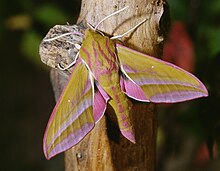Deilephila elpenor
| Elephant hawk-moth | |
|---|---|
 |
|
| Scientific classification | |
| Kingdom: | Animalia |
| Phylum: | Arthropoda |
| Class: | Insecta |
| Order: | Lepidoptera |
| Family: | Sphingidae |
| Genus: | Deilephila |
| Species: | D. elpenor |
| Binomial name | |
|
Deilephila elpenor (Linnaeus, 1758) |
|
| Synonyms | |
|
|
Deilephila elpenor, known as the elephant hawk-moth, is a large moth of the Sphingidae family.
The species is found throughout Britain and Ireland. Its range extends across Europe, Russia, and into China, northern parts of the Indian subcontinent, Japan and Korea (though not Taiwan). Introduced specimens have been found in British Columbia. In most of their range, the adults are seen from May to July and the caterpillars from July to September, when they pupate. However, in some parts of the Mediterranean and China the adults may be seen from April on, sometimes having two broods in a year.
The larva is about 75 millimetres (3.0 in) long, green and brown in colour. Like most hawk moth caterpillars, they have a backward curving spine or "horn" on the final abdominal segment. The anterior of the caterpillar appears to have the shape of a trunk-like snout. It is this elephant look, rather than its large size, that gives the moth its name. When startled, the caterpillar draws its trunk into its foremost body segment. This posture resembles a snake with a large head and four large eye-like patches. Caterpillars are preyed upon by birds, but these shy away (at least for some time) from caterpillars in "snake" pose. It is not known whether the birds take the caterpillar to actually resemble a snake, or are frightened by the sudden change of a familiar prey item into an unusual and boldly-patterned shape.
The preferred food plants of the caterpillar are willowherb (Epilobium) and bedstraw (Galium), though it will also take fuchsias.
...
Wikipedia
